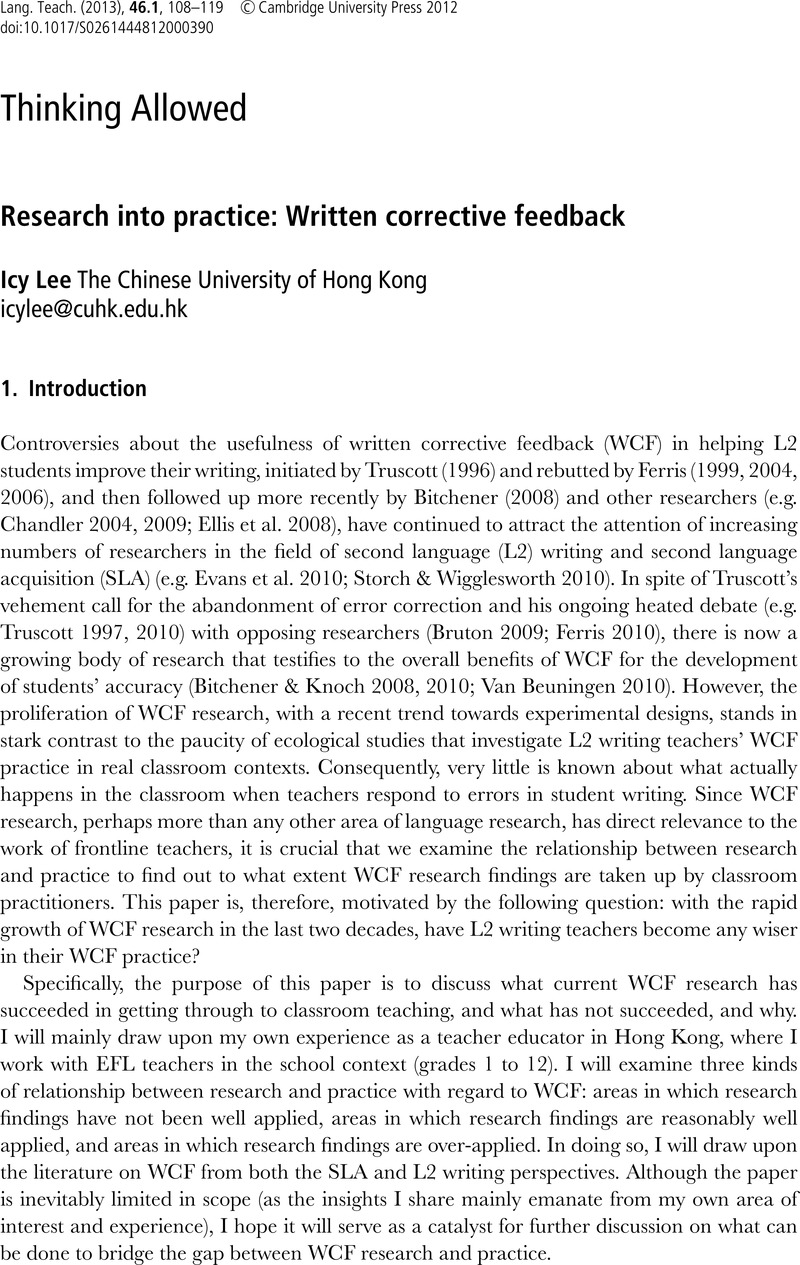Crossref Citations
This article has been cited by the following publications. This list is generated based on data provided by Crossref.
Busse, Vera
2013.
How do students of German perceive feedback practices at university? A motivational exploration.
Journal of Second Language Writing,
Vol. 22,
Issue. 4,
p.
406.
McMartin-Miller, Cristine
2014.
How much feedback is enough?: Instructor practices and student attitudes toward error treatment in second language writing.
Assessing Writing,
Vol. 19,
Issue. ,
p.
24.
Icy Lee
2014.
Teachers’ Reflection on Implementation of Innovative Feedback Approaches in EFL Writing.
English Teaching,
Vol. 69,
Issue. 1,
p.
23.
Hui, Bronson
2015.
TESOL: A Guide.
System,
Vol. 55,
Issue. ,
p.
163.
Nakata, Tatsuya
2015.
Effects of feedback timing on second language vocabulary learning: Does delaying feedback increase learning?.
Language Teaching Research,
Vol. 19,
Issue. 4,
p.
416.
Larsen-Freeman, Diane
2015.
Research into practice: Grammar learning and teaching.
Language Teaching,
Vol. 48,
Issue. 2,
p.
263.
Lawley, Jim
2016.
Spelling: computerised feedback for self-correction.
Computer Assisted Language Learning,
Vol. 29,
Issue. 5,
p.
868.
John Burrell
이제영
and
Jee Eun Lee
2016.
Korean University Student Preferences for Written Corrective Feedback on English Writing.
Journal of the Korea English Education Society,
Vol. 15,
Issue. 3,
p.
35.
Reynolds, Barry Lee
and
Kao, Chian-Wen
2016.
More than a response to Andrew Sampson’s (2012) “Coded and uncoded error feedback: effects on error frequencies in adult Colombian EFL learners’ writing”: a call for replication.
Asian-Pacific Journal of Second and Foreign Language Education,
Vol. 1,
Issue. 1,
Paran, Amos
2017.
‘Only connect’: researchers and teachers in dialogue.
ELT Journal,
Vol. 71,
Issue. 4,
p.
499.
Nemati, Majid
Alavi, Sayyed Mohammad
Mohebbi, Hassan
and
Masjedlou, Ali Panahi
2017.
Teachers’ writing proficiency and assessment ability: the missing link in teachers’ written corrective feedback practice in an Iranian EFL context.
Language Testing in Asia,
Vol. 7,
Issue. 1,
Bonilla López, Marisela
Van Steendam, Elke
and
Buyse, Kris
2017.
Comprehensive corrective feedback on low and high proficiency writers.
ITL - International Journal of Applied Linguistics,
Vol. 168,
Issue. 1,
p.
91.
Lee, Icy
2017.
Classroom Writing Assessment and Feedback in L2 School Contexts.
p.
65.
Jakobson, Liivi
2018.
Teacher written feedback on adult beginners’ writing in a second language.
ITL - International Journal of Applied Linguistics,
Vol. 169,
Issue. 2,
p.
235.
Bonilla López, Marisela
Van Steendam, Elke
Speelman, Dirk
and
Buyse, Kris
2018.
The Differential Effects of Comprehensive Feedback Forms in the Second Language Writing Class.
Language Learning,
Vol. 68,
Issue. 3,
p.
813.
Mak, Pauline
2019.
From traditional to alternative feedback: What do L2 elementary students think?.
International Journal of Applied Linguistics,
Vol. 29,
Issue. 1,
p.
109.
Nemati, Majid
Alavi, Sayyed Mohammad
and
Mohebbi, Hassan
2019.
Assessing the effect of focused direct and focused indirect written corrective feedback on explicit and implicit knowledge of language learners.
Language Testing in Asia,
Vol. 9,
Issue. 1,
Hardman, William
and
Bell, Huw
2019.
‘More fronted adverbials than ever before’. Writing feedback practices and grammatical metalanguage in an English primary school.
Language and Education,
Vol. 33,
Issue. 1,
p.
35.
Mao, Zhicheng
and
Lee, Icy
2020.
Feedback scope in written corrective feedback: Analysis of empirical research in L2 contexts.
Assessing Writing,
Vol. 45,
Issue. ,
p.
100469.
Cumming, Alister
2020.
Writing and Language Learning.
Vol. 56,
Issue. ,
p.
29.


